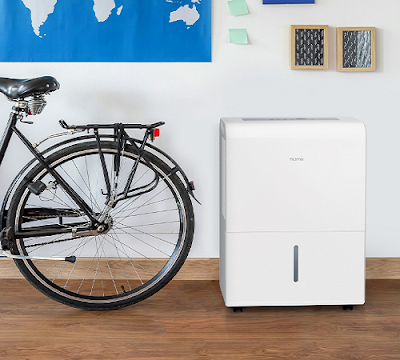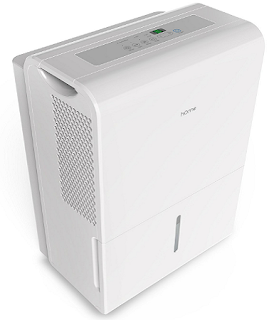Best Dehumidifiers 70 pint for basements Large Rooms ǀ hOmeLabs 9 Gallon - Dehumidifier Energy Star. Dehumidifiers for 4 bedroom house. Protect your home or basement from mold and mildew, and breathe easy with the Energy Star certified hOme 9 Gallon Dehumidifier. Most reliable dehumidifiers. It quickly and effectively reduces odor and bacteria through its powerful built-in pump compressor, and removes up to 9 gallons (70 pints) of moisture from surrounding humid air per day.
Top dehumidifiers. Energy star certified 9 gallon (70 pint) dehumidifier quickly and effectively removes excess moisture from basements or large rooms to help protect your home from mold and mildew, and features continuous dehumidifying operation for 24 hour cycles.
Dehumidifiers 70 pint. Regulate your environment for health and comfort with the hOmeLabs 9 Gallon 70-Pint Dehumidifier. It can eliminate up to 70 pints of fluid from the air per day, which can help to reduce bacteria, molds and mildew throughout your home. This hOmeLabs 9 Gallon dehumidifier operates at a low temperature, Energy star rated mid size 9 gallon (70 pint) dehumidifier for basements or large rooms with continuous dehumidifying operation.
Dehumidifiers For Dust Mite
Humidity, we’ve all experienced it. Some people hate the feeling of moist air and others welcome it. Humidity can help keep our skin supple and moist, but when there’s too much it can be uncomfortable.
When it rains there is an increase of humidity and we also experience humidity during hot, muggy summers. In the East, South, and Mid-West of the U.S. humidity is something we have to live with.
However protecting our homes from humidity by using dehumidifiers might be a smart decision to reduce allergies from dust mites and mold.
In this article I’ll share the best humidifiers for dust mite and mold allergies. These should put you on the right track to improve your indoor air humidity.
Dehumidifiers work by effectively sucking in air, removing the moisture, then redistributing the air into the room. It’s really not much different than an air conditioner except there is a container where water is held once the moisture has been removed.
Because a dehumidifier collects water, it will need to be emptied occasionally, and sometimes daily on humid days. Some dehumidifiers use hoses that connect directly to a drain. On real humid days some dehumidifiers can remove liters of water from the air.
Good quality dehumidifiers also filter the air, so you get lower humidity and fresh filtered air….perfect for people like me who suffer from allergies.
What Dehumidifier Do I Need
Before looking at the selections of dehumidifier you might ask yourself “what type of dehumidifier do I need”. The answer to that question depends on a number of factors.
Severity of humidity
Most people purchase a dehumidifier because they are looking to reduce the amount of moisture throughout their home. It might be seasonal – during warm summers, or the humidity can be a problem year-round if in a more tropical area. If the humidity stronger in a particular room, a small dehumidifier might be useful.
If the humidity is spread throughout the house, a larger, 70-pint dehumidifier will be helpful and can be placed in a basement or laundry room.
Is it just a problem with humidity in the bathroom
It’s understandable if the humidity is only in the bathroom. Warm showers and baths can create steam, which makes a bathroom moist – the perfect environment for mold growth. Humidity in a bathroom becomes a problem when there is inadequate ventilation.
The first thing you can do is to open a window in the bathroom while bathing to let hot air escape. In the winter, this may sound like a bad idea, but it will help with ventilation.
If ventilation can’t be improved, a bathroom dehumidifier will work great and help reduce moisture damage to walls and discourage mold growth. Small dehumidifiers also work great for bedrooms and offices that have poor ventilation.
Do you have a humid basement
In the Western U.S. most homeowners don’t have a basement. But in many homes across the Mid-West, East, and South basements are common.
Because they are built into soil, there are often problems with moisture. If there is a high water table, or if there are frequent rains, the moisture can seep into the basement (hence, the need for sump pumps and drainage.
If you have a humid basement a dehumidifier will help significantly. The great thing about a dehumidifier in the basement is you’ll likely be able to feel results in the upper levels of the house.
A large dehumidifier in the basement can be attached to a sink with a hose and run around the clock. Frigidair and Keystone make dependable options that are big enough for the whole basement.
Do you have excess moisture in your crawl space
A crawl space dehumidifier might be your best bet if you have a moist crawl space under the house. If a crawl space is wet and damp, it can be the perfect place for mold growth and it could slowly start to rot your house foundation.
The great thing about a crawl space dehumidifier is it tucked under the house, unseen, and quiet enough that it won’t bother people while running all night.
Remember, a crawl space dehumidifier will reduce moisture from the area and stop mold growth in its tracks, however it won’t totally kill the mold. You may have to go down there with a spray bottle of water/bleach to zap the existing mold.
Too much moisture in the crawl space is often an allergy-causing problem that homeowners don’t realize. If you own a house with a crawl space, it’s wise to occasionally look under the house (or attic area) to see the conditions.
What is your budget
Lastly, what is your budget? For their important purpose, the cost of buying a dehumidifier is reasonable – especially if they help improve dust mite and mold allergies.
Understandably, small rooms or bathroom dehumidifiers are the cheapest. Larger room or basement dehumidifiers can run a few hundred dollars. They are great quality from reliable brands, many with energy star ratings.
A crawlspace dehumidifier cost is considerably more expensive, however the best brands offer up to 6 year warranties, are energy star efficient, can be mounted to floorboards or other foundation, and can have hoses up to 20 feet away to drain water.
The Best Dehumidifiers For Indoor Allergies
HOMELABS 9 GALLON (70 PINT) DEHUMIDIFIER ENERGY STAR SAFE MID SIZE PORTABLE DEHUMIDIFIERS
Dehumidifiers For Indoor Allergies
“Two words, Quiet and Dry. We needed a large dehumidifier for our basement and hOmeLabs has exceeded our expectations. Seriously, you don’t understand how humid and damp your house is until use try it. This dehumidifier is easy to use, runs quietly and stops when full. Doesn’t look bad either.” – hOmeLabs customer.
# dehumidifiers for 4 bedroom house
# dehumidifiers for 4 bedroom house
Why Is Indoor Humidity A Problem
Indoor humidity isn’t always a bad thing. In fact, without humidity the air would be extremely dry. The dry air would also affect our skin moisture.
When humidity increases inside our home it can cause all kinds of problems, especially if ventilation is poor. High humidity can cause:
*Mold
*Food to become soggy and ruined
*Problems with electronics (short-circuiting etc.)
*Increase health issues by promoting bacteria and virus growth as well as mites that rely on humidity to survive.
There is a recommended relative humidity level that is perfect for indoors and it is 40-60%.
Why Is Humidity Bad For Allergies
Not all cases of allergy become worse with humidity. Some people who suffer from asthma often find that humidity helps relax their lungs. Problems emerge however when people are allergic to dust mites and mold.
Dust mites rely on moisture but interestingly they don’t drink water. They absorb all their moisture needs from the air through their skin. In low humidity environments they slowly die off or become less active. In high humidity environments they reproduce quickly!
The same is true for mold, which is a fungus. More moisture allows fungi to thrive, while lower humidity can dry out fungi.
I experienced an increase in dust mite allergy when I lived in Washington D.C. and it coincided with the humid summer season. My symptoms were:
*Red itchy eyes
*Congested nose
*Itchy mouth and eczema skin
*Itchy ears
Basically, my respiratory system, especially my sinus were getting the worst of it. The indoor air was thick and the couches in basement were a little damp. Since I was living in the basement I started to experience allergy symptoms and I wasn’t sure what it was.
Come to find out later, it was likely a combination of dust mites and mold. Shortly after my experience, my family purchased a dehumidifier for the whole house and placed it in the basement.
I was astonished at the amount of water it collected in one day. I also felt the difference in the entire house. The air felt more crisp, fresh, and definitely didn’t fell like I wasn’t living in the South.
The list below consolidates the best dehumidifiers on the market for people suffering with dust mite and mold allergy. We recommend these because of their popularity, ease of use, and function (room or whole house). We also consider the reviews on amazon.com which detail positive and negative experiences.
You will noice a “pint size” listed with each dehumidifier. Keep in mind that the pint size is based on the amount of water that be collected per day.
A 70-pint dehumidifier will remove 70 pints per day (approximately .5 liters). A higher pint size basically means the dehumidifier is larger and more efficient. Smaller pint size is fine for smaller spaces.
Dehumidifiers where to buy - Best dehumidifiers
best dehumidifiers
Product highlights:
✔Perfect for large rooms (4000 square feet)
✔Wheels for easier movement
✔Comes with drain hose for continuous use
✔Auto shut off with 9 gallon (70 pint) tank
✔Nice, modern design
✔Reduces odor and bacteria
You might not be familiar with the HomeLab company, but we sure are. Home makes indoor electric products ranging from cookers, to ac units, to humidifiers. Most of their products are energy efficient including this one.
We like Home’s dehumidifier because it makes a great first impression (appearance) and runs quietly. Becuase it’s energy efficient it won’t surprise you on your electricity bill either. The control panel is digital with push button controls.
Buy hOmeLabs 9 Gallon 70-Pint Dehumidifier with Effortless Humidity Control, White: Home & Kitchen - Amazon.com
So there you have it. If you’re looking for a dehumidifier to help with reducing dust mite or mold allergies, then this review should help your search. Dehumidifiers work well inside the home, especially in basements and bedrooms where allergies can affect us the worst.
They come in various sizes, using “pints”, which collect the amount of water per day. Whether you’re looking for a large whole-house dehumidifier or smaller room-size dehumidifier we’ve provided the information to get you started. Visit our Dust Mite Solutions blog to learn more information on dust mite and allergy control.



Add Your Comments